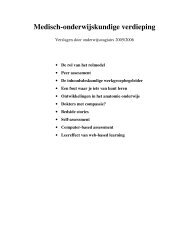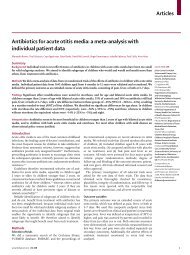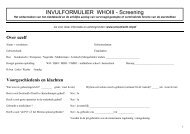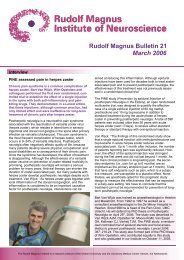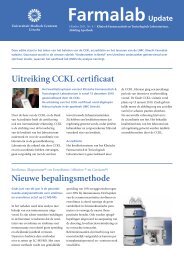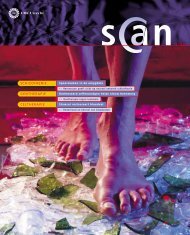Predictors of disease outcome in rheumatoid arthritis - UMC Utrecht
Predictors of disease outcome in rheumatoid arthritis - UMC Utrecht
Predictors of disease outcome in rheumatoid arthritis - UMC Utrecht
You also want an ePaper? Increase the reach of your titles
YUMPU automatically turns print PDFs into web optimized ePapers that Google loves.
Cop<strong>in</strong>g and Social Support <strong>in</strong> Disease Activity - 39<br />
for short-term <strong>disease</strong> fluctuations (Affleck et al., 1997; Zautra et al., 1997) may be<br />
irrelevant to long-term <strong>outcome</strong>s (McFarlane & Brooks, 1990; Affleck et al.,<br />
1997). In contrast to short-term changes from <strong>in</strong>cidental stress encounters and<br />
responses, long-term effects may be primarily <strong>in</strong>fluenced by chronic stressors and<br />
relatively stable personality, cop<strong>in</strong>g and social support characteristics. Also the<br />
strength and direction <strong>of</strong> relationships between stress and vulnerability factors and<br />
<strong>disease</strong> activity may vary over time and be different for short and long-term<br />
<strong>outcome</strong>s. Some effects may become evident only <strong>in</strong> the long term and factors may<br />
even work <strong>in</strong> opposite directions <strong>in</strong> different time periods, e.g. due to a biphasic<br />
pattern <strong>of</strong> immunological or behavioral responses that is differently related to<br />
<strong>disease</strong> activity dur<strong>in</strong>g and after the occurrence <strong>of</strong> major stress (Mullen & Suls,<br />
1982; Koehler, 1985; Suls & Fletcher, 1985; McFarlane & Brooks, 1990; Huyser<br />
& Parker, 1998). F<strong>in</strong>ally, effects may also depend on the stages <strong>of</strong> <strong>disease</strong> assessed<br />
(McFarlane & Brooks, 1990; Huyser & Parker, 1998). Prelim<strong>in</strong>ary evidence<br />
suggests that stressors and vulnerability factors are differently related to physical<br />
and psychological symptoms <strong>in</strong> early and long-stand<strong>in</strong>g RA (Smith et al., 1997),<br />
possibly due to changes brought about by the <strong>disease</strong> itself. Stressors and<br />
vulnerability factors <strong>in</strong> established RA have been shown to be affected by the<br />
<strong>in</strong>flammatory processes <strong>of</strong> the <strong>disease</strong>, its biopsychosocial consequences and the<br />
pharmacological treatment with prolonged medication (Evers et al., 1997; Fex et<br />
al., 1998; van Jaarsveld et al., 1998, 2000; Penn<strong>in</strong>x et al., 1999), and they may be<br />
consequently more validly assessed <strong>in</strong> recently diagnosed patients (Zautra et al.,<br />
1989; Smith et al., 1997; Huyser & Parker, 1998).<br />
The purpose <strong>of</strong> the present study was to exam<strong>in</strong>e the role <strong>of</strong> stress-vulnerability<br />
factors for their ability to predict long-term changes <strong>in</strong> <strong>disease</strong> activity <strong>in</strong> recently<br />
diagnosed RA patients. Specifically, we studied the relative contribution <strong>of</strong><br />
personality characteristics (neuroticism and extraversion), physical and<br />
psychological stressors (chronic <strong>disease</strong>-related stressors <strong>of</strong> functional disability,<br />
pa<strong>in</strong>, and <strong>disease</strong> impact on daily life, as well as major life events), cop<strong>in</strong>g and<br />
social support at the time <strong>of</strong> diagnosis to changes <strong>in</strong> <strong>disease</strong> activity 1, 3 and 5<br />
years later. In l<strong>in</strong>e with prelim<strong>in</strong>ary evidence suggested by current theories and<br />
research, it was hypothesized that a more unfavorable course <strong>in</strong> <strong>disease</strong> activity<br />
after 1, 3 and 5 years could be directly predicted by personality characteristics <strong>of</strong><br />
more neuroticism and less extraversion, higher levels <strong>of</strong> physical and<br />
psychological stressors, more passive avoidant cop<strong>in</strong>g, less active problem-focused<br />
cop<strong>in</strong>g and less social support at the time <strong>of</strong> diagnosis. In addition to these direct<br />
effects, several mediator and moderator effects were exploratively <strong>in</strong>vestigated.<br />
First, the mediat<strong>in</strong>g function <strong>of</strong> cop<strong>in</strong>g and social support for the relationship<br />
between personality characteristics and change <strong>in</strong> <strong>disease</strong> activity and for the<br />
relationship between stressors and change <strong>in</strong> <strong>disease</strong> activity was exam<strong>in</strong>ed. In<br />
addition, the mediation function <strong>of</strong> stressors for the relationship between<br />
personality characteristics and change <strong>in</strong> <strong>disease</strong> activity, and <strong>of</strong> cop<strong>in</strong>g for the




